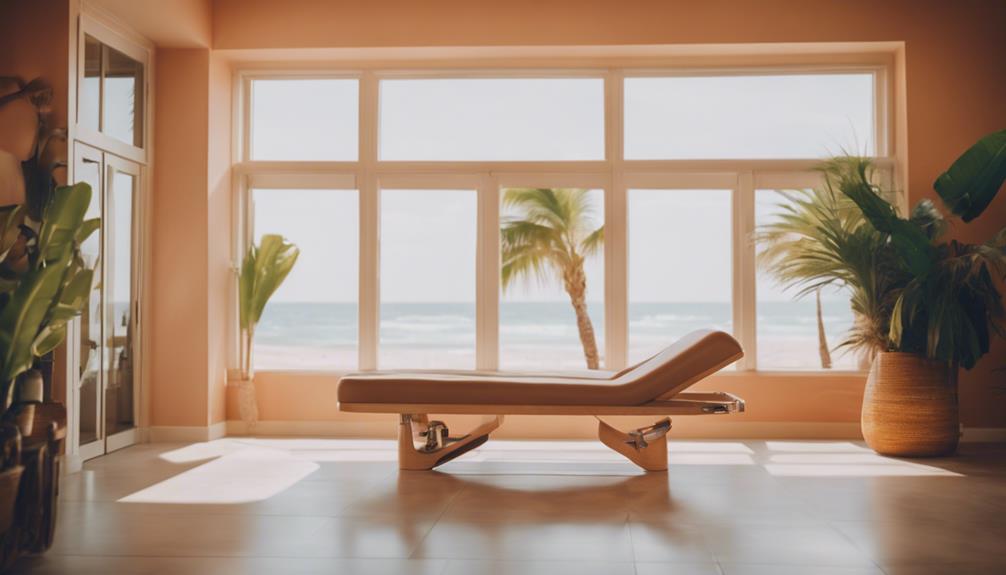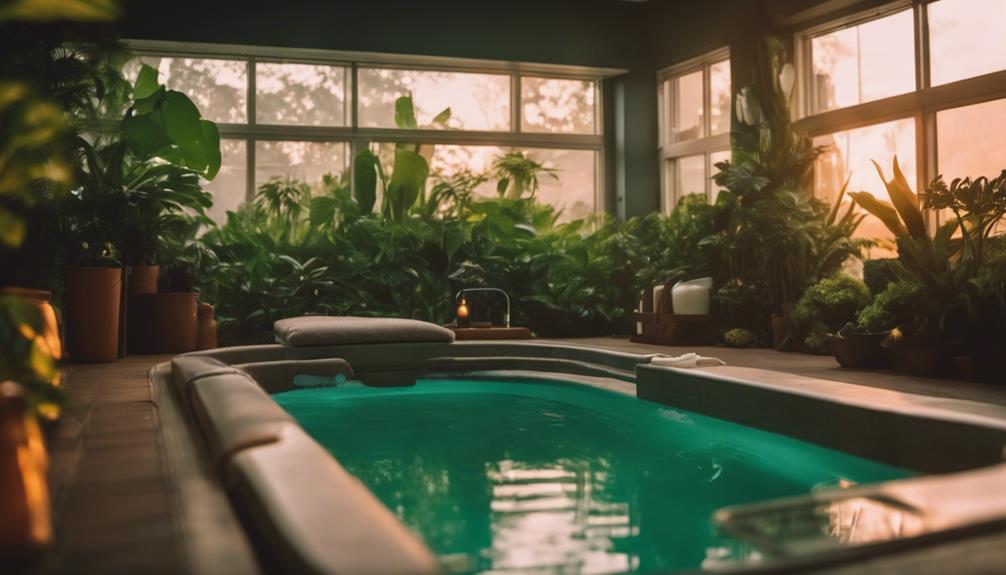Timing your outfit after applying fake tan is crucial for achieving a flawless appearance. It is recommended to wait at least 1-2 hours for the tanner to dry and set properly, as rushing the process can result in uneven fading and streaks. Opt for dark, loose-fitting clothing made from breathable materials like cotton to prevent smudging and ensure even tan development. Avoid tight or synthetic fabrics that may disrupt the appearance of the tan. If you have plans for a night out, choose airy pieces that beautifully showcase your glowing skin. Stay tuned for more tips on maintaining your tan’s best look!
Key Takeaways
- Wait at least 1-2 hours after applying self-tanner to allow it to dry and set properly.
- Choose dark, loose-fitting clothing made from breathable fabrics to protect your tan.
- Avoid tight clothing as it can lead to uneven fading and smudging of the tan.
- For evening wear, opt for flowy dresses or jumpsuits to enhance breathability and comfort.
Importance of Timing
Timing is essential after fake tanning, as it directly affects the quality and longevity of your tan. You need to wait at least 1-2 hours for the self-tanner to fully dry and set before you shower or expose your skin to water.
Rushing this process can lead to uneven fading and streaking, ruining your hard work. Each self-tanner has unique drying times, so be patient. To help speed things up, use a fan for even drying.
Once your tan is set, opt for dark, loose-fitting cotton clothes to avoid smudging. Remember, the right timing not only enhances the tan's appearance but also keeps it looking fresh and smooth longer.
Don't underestimate the importance of this step!
Optimal Waiting Period
After applying your self-tanner, it's important to wait at least 1-2 hours for it to dry completely before getting dressed or showering.
This waiting period is essential for ensuring your tan develops evenly and maintains its quality. Each self-tanner has different drying times, so be patient.
If you want to speed things up, consider using a fan to help dry the product more quickly. Remember, rushing the process can lead to uneven fading or streaks, which can ruin your desired look.
Once the time has passed and your tan feels dry, you can confidently put on your outfit without worrying about smudging or disrupting your new glow.
Enjoy flaunting that beautiful tan!
Clothing Material Choices

What types of clothing materials should you choose to guarantee your tan stays flawless and vibrant? You'll want to opt for dark, loose-fitting fabrics that won't rub against your skin and disturb the tan. Cotton is a great choice, as are rayon and modal for extra comfort.
Here's a quick reference table to guide your material choices:
| Material Type | Recommendation |
|---|---|
| Cotton | Excellent choice |
| Rayon | Comfortable alternative |
| Modal | Soft and breathable |
| Synthetic Fabrics | Avoid |
| Tight Clothing | Avoid |
Choosing the right materials not only protects your tan but also keeps you feeling comfortable and confident all day long.
Effects of Tight Clothing
Tight clothing can considerably disrupt your tan, leading to uneven fading and unsightly streaks. When you wear snug outfits, the fabric rubs against your skin, which can cause the tan to lift off or smudge. This is especially true with synthetic materials that don't allow your skin to breathe.
You might think you look great in form-fitting attire, but the aftermath can be disappointing. Instead, opt for loose, dark clothing made from breathable fabrics like cotton. This way, you'll protect your tan and maintain an even glow.
Evening Wear Considerations

Choosing the right evening wear is just as important as avoiding tight clothing, as it can help you showcase your tan while ensuring it stays intact.
Opt for flowy dresses or airy jumpsuits made from breathable fabrics like cotton or rayon. These choices allow your skin to breathe and prevent any rubbing that could disrupt your tan.
Dark colors work best to minimize the risk of noticeable stains and enhance your sun-kissed glow.
When it comes to footwear, select options that are comfortable and loose-fitting, steering clear of anything too tight.
Protecting Your Tan Overnight
To protect your tan overnight, slip into loose, dark pajamas made of breathable materials that won't rub against your skin while you sleep.
Tight clothing can cause your tan to smudge or fade unevenly, so give your skin room to breathe.
Consider using a sheet protector on your bed to prevent any transfer of color onto your bedding.
Avoid tossing and turning too much; a light blanket can keep you covered without causing friction.
If you have long hair, tie it back loosely to prevent it from rubbing against your neck or shoulders.
Tips for Lasting Results

Maintaining your tan's vibrancy requires consistent hydration and gentle care for your skin. Follow these tips for lasting results that'll keep you glowing:
- Hydrate daily: Drink plenty of water to keep your skin plump and radiant. Your tan deserves it!
- Moisturize regularly: Use a high-quality moisturizer to prevent dry patches and prolong your tan's life. Your skin will thank you!
- Limit exfoliation: Avoid harsh scrubs; instead, opt for gentle exfoliation to maintain an even tone. Smooth skin equals a smooth tan!
- Avoid hot showers: Hot water can strip your skin and fade your tan faster. Stick to lukewarm water for a softer, longer-lasting glow.
Frequently Asked Questions
Can I Wear Jewelry Immediately After Tanning?
You shouldn't wear jewelry immediately after tanning. It can leave marks or disrupt the evenness of your tan. Wait a couple of hours to let the tan set properly, ensuring a flawless finish.
What Should I Do if I Accidentally Get Wet?
If you accidentally get wet, don't panic! Blot your skin gently with a towel, avoiding rubbing. Let it dry completely before evaluating any damage, and consider reapplying self-tanner for a flawless finish.
How Can I Fix Streaks After Tanning?
If you notice streaks after tanning, gently exfoliate the area with a loofah or scrub. Then, apply a tinted moisturizer or self-tanner to blend and even out the color for a smoother finish.
Is It Safe to Exercise Before the Tan Sets?
Imagine your tan as a delicate artwork; exercising before it sets can smudge that masterpiece. You'd want to wait until it's fully dry to keep it flawless and vibrant. Patience pays off!
What Type of Fabric Should I Avoid Entirely?
You should avoid tight, synthetic fabrics entirely. They can rub against your skin, causing your tan to streak or smudge. Opt for loose, breathable materials instead to maintain that flawless, sun-kissed look you desire.
Does Fake Tanning Method Affect the Timing of Outfit Selection?
The standup vs laydown tanners showdown may impact outfit selection. Standup tanners might have darker results and shorter development time, influencing clothing choices. Laydown tanners might need to plan outfits around longer development times. Consider the tanning method when selecting the perfect outfit for your bronzed look.
How does fake tanning affect safe tanning bed timing?
When it comes to mastering tanning bed timing, fake tanning can affect it in a way that it may make your skin more sensitive to UV rays. This could potentially alter the recommended safe tanning bed timing, as the skin may require shorter sessions to prevent overexposure and potential damage.
Conclusion
Timing your outfit after fake tanning is like mastering a dance; it requires rhythm and patience.
By waiting the ideal time, choosing the right materials, and avoiding tight clothing, you can guarantee your golden glow lasts longer.
Think of your tan as a delicate work of art—treat it with care to keep it vibrant and flawless.
With these tips, you'll step out confidently, showcasing your radiant look, just like a masterpiece in the spotlight.










